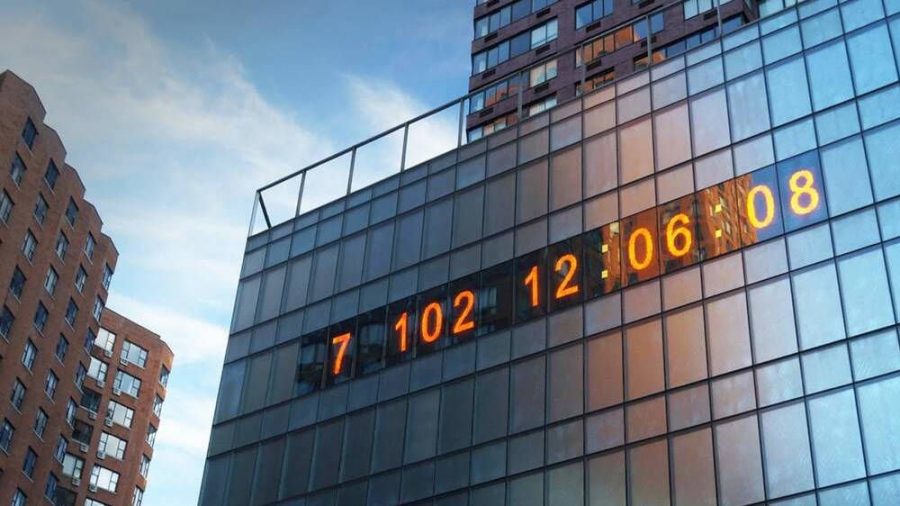Union Square Climate Clock Serves as an Alarming Symbol
Each day, we move through our lives unaware — or perhaps willfully ignorant — of the looming catastrophe that we face in the form of climate change. The recently unveiled “Climate Clock” in Union Square serves as a constant reminder of the “deadline” before the effects of carbon emissions on Earth are irreversible. The project features two opposing “clocks,” one that shows how long it will take “at current rates of emissions, to burn through our ‘carbon budget’ — the amount of CO2 that can still be released into the atmosphere while limiting global warming to 1.5°C above pre-industrial levels.” The second “clock” represents Earth’s “lifeline”: the percentage of the world’s energy that comes from renewable sources. To avoid large-scale catastrophe from global warming, the lifeline clock must reach 100% before the carbon budget clock reaches zero.
The clocks themselves are not meant to simply provide shock value, as they are based on data from a 2018 report written by the Intergovernmental Panel on Climate Change. There is nothing subjective about climate change; there is a deadline for the leaders of the world to create policy that will ensure a safe future.
Part of the inspiration for the Climate Clock comes from the Doomsday Clock, a clock that counts down to a symbolic “midnight” at which the destruction of the world through nuclear disaster or any other catastrophic event is imminent. As the minute hand moves closer to “midnight,” Earth moves closer to its demise. A report is released annually by the Bulletin of the Atomic Scientists and is supported by a board that includes a former United States governor, 13 Nobel laureates and many distinguished professors. The 2020 report, released in January, states that there are only 100 seconds until “midnight,” the closest that we have ever come since the establishment of the Doomsday Clock. For reference, in 1991, there were 17 minutes until midnight. The message conveyed by both the Climate and Doomsday Clocks is that the world is at a tipping point, and the decisions that we make in the immediate future will have serious long-term implications.
Educating people about the present danger that we face is extremely important, and public installations such as the Climate Clock are crucial to the survival of people across the world. The consequences of failing to convert all the world’s energy to renewable sources before the clock strikes zero include floods, droughts, uninhabitable regions and mass extinctions. Responsibility for avoiding large-scale catastrophes such as these falls on the shoulders of the world’s governments and corporations, as well as the general public. It is imperative that governments set politics aside and pursue policies that scientists dictate are necessary.
However, the Trump administration seems to be intent on moving the United States in the opposite direction. In 2017, President Trump withdrew from the Paris Climate Accords, a global agreement aimed at reducing emissions and keeping global warming to 1.5°C above pre-industrial levels — the same target reflected by the Climate Clock. The public has the responsibility to vote for leaders and representatives who respect science, acknowledge our current circumstances and prepare to take decisive action.
Furthermore, we should be shopping at businesses that are committed to controlling their emissions and making eco-friendly choices with their products. While this isn’t always possible, we should commit ourselves to use the power that we have as consumers to affect positive change as much as possible. I would be remiss if I failed to mention that corporate greed is one of the major reasons we find ourselves in this climate emergency. From fracking to fast fashion, corporations have been abusing the environment for far too long. As we now begin to pay the price for their actions, it is the responsibility of corporations to change their practices and help clean up the mess that they have made.
If moral arguments and the prospect of saving lives won’t compel companies to change the way that they operate, their bottom lines certainly will. According to the New York Times, the world’s largest companies have estimated that at least $250 billion of assets may need to be forfeited as a result of climate change. These assets reportedly include buildings in high-flood-zones and power plants that would have to shut down due to tighter regulations.
The Climate Clock in Union Square showcases “arguably the most important number in the world,” as said by one of the creators, Andrew Boyd. The clock succeeds in reminding us that unless we take decisive action in all aspects of our lives, climate change will forever destroy the world as we know it. We face a daunting task in slowing the effects of climate change. Considering the consequences, it seems almost impossible to make any gesture grand enough to change the circumstances that we find ourselves in. All we can do is make conscious choices that help the environment every single day, always bearing the Climate Clock in mind. Picture the seconds ticking away and do your very best. Vote this November as if your life depends on it, because our future is on the line.
Julian Shuttleworth, FCRH ’24, is a political science major from Columbus, Ohio.










































































































































































































